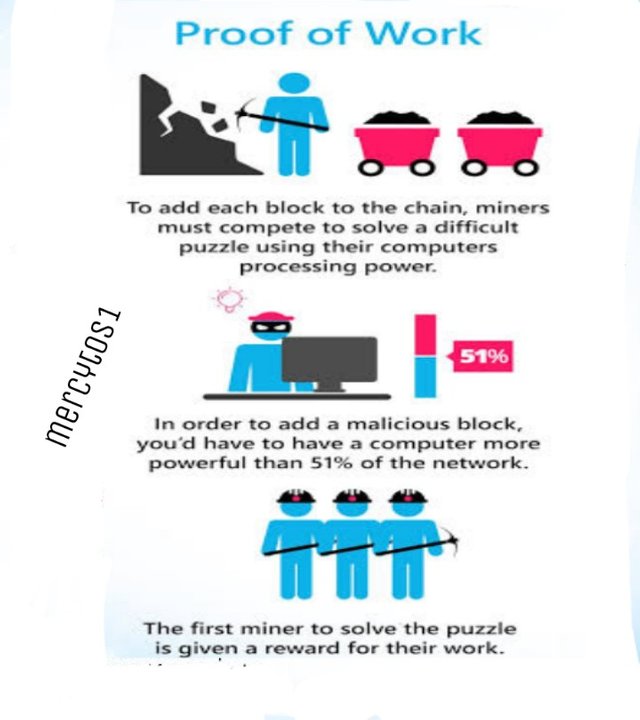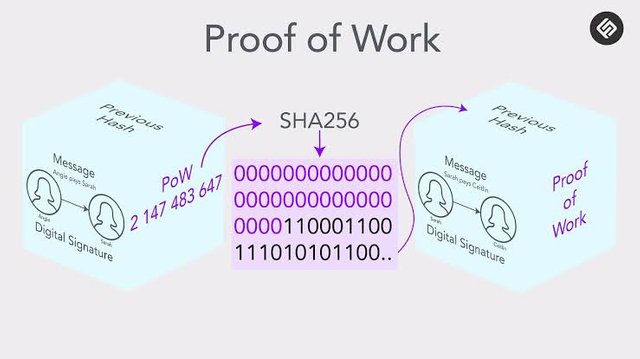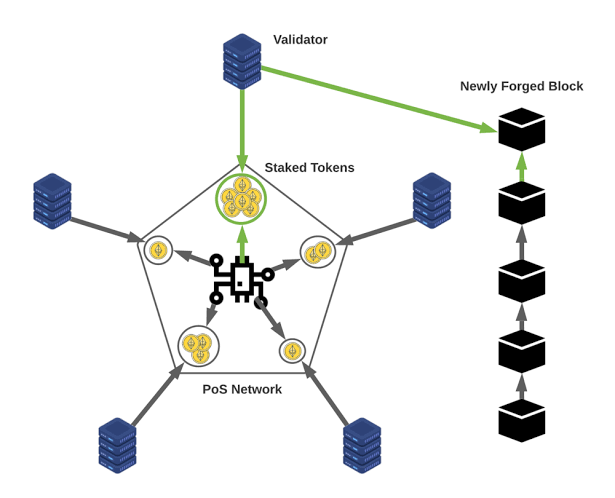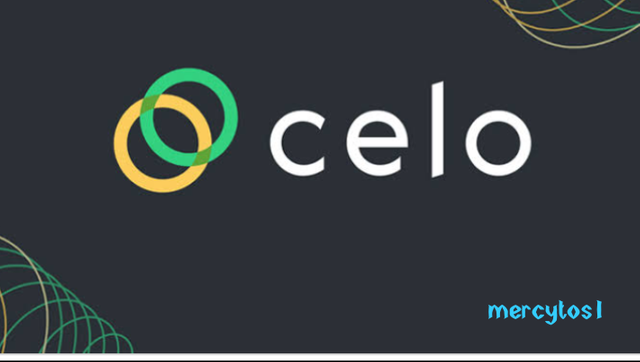[PoS and PoW] - Steemit Crypto Academy Season 5 - Homework Post for Task 06
(1) What is the difference between PoW & PoS? Advantages & Disadvantages? Which one is better in scaling Capacity? Examples?
PoS and PoW
Consensus mechanism is a very important aspect of the blockchain technology, it is known as the backbone of the cryptocurrency space. A consensus mechanism is the principle used for block verification in a blockchain, it gives requirements that are to be met by both the nodes and validators before the creation of a new blockchain. Over the past years alot of consensus mechanism has emerged and has been used consistently in blockchain technology, this is what brings us to Proof of Work (PoW) and Proof of Stake (PoS) which we will be discussing below. The PoW and PoS are both used for validating trànsactions as they are the mining system used on a blockchain.
PROOF OF WORK (PoW)

The first consensus mechanism to be created is proof of work, as it is associated with the first cryptocurrency, it was used in the Bitcoin blockchain. It can be said that Proof of Work is the father of consensus mechanism, Nakomoto Satoshi was the first to implement the use of the PoW when he launched the Bitcoin blockchain although it was theoretically published in 2004 by HAL FINNEY.

Source: forkast
Just as the name implies proof of work it simply means that a task is done to get a reward after the proof that the work been done is seen. In a crypto inclined way we can say Proof of work is a system which is decentralized that allows miners to solve difficult mathematical problems with their computers with the aim of solving the problem first so as to get rewarded.
It is very essential to ensure that tokens aren't spent twice for different transaction before the verification of the transactions. This consensus mechanism is very vital in the formation of a new block and verification of transactions on that particular blockchain. Each time a miner successfully completed a take a new block is approved on the network. The miners usually solve the problem given to them which is then verified by other miners to get the correct answer if this is done, the first person to provide the right solution will then be rewarded, and the process starts all over again.
The Proof of Work is difficult to tamper with because all the blocks will need to be edited of any of the blocks on the blockchain is to be altered and this is why it is quite difficult to tamper with.
PROOF OF STAKE (PoS)

Proof of stake is another type of consensus mechanism that doesn't require mining of the coin on the network but it makes use validators, this doesn't need powerful computers to earn coin rather validators or forgers stake some certain amount of their crypto on the network, the network is then built in such a way that the staker with the highest number of stake is chosen to validate the transaction of the network for that block, after which the validator then gets some percentage of the gas fee for every transaction done on the block.
The choosing of validators is usually done randomly by the POS protocol but it is essential to have a larger amount of stake so as to have a higher chance of been chosen as the validator for a particular block, every staked token is usually locked up and which is used to secure the network.
DIFFERENCES BETWEEN PROOF OF STAKE AND PROOF OF WORK
There are various differences between the two consensus mechanism as we must have seen from the explanations above, let's look at some more differences between them below.
1 . The proof of work uses miners as their validating nodes while the proof of stake uses validators or forgers as their validating nodes.
2 . The proof of work makes use of alot of energy or let's say it consumes lots of energy whenever mining is ongoing due to the computational work that needs to be done and the computer that does this work uses alot of energy while the proof of stake uses little or no energy as the only thing need is the crypto to be staked.
3 . The rewards given in the proof of work is known as the block reward which is usually the coin of that network while the proof of stake gives the transaction fee to the validator of that particular block
4 . The computer used to mine in the proof of work is very expensive which makes it difficult for all to afford which gives the network higher security as no one will be able to purchase about 51% of the computer to spam the network while the proof of stake doesn't require the computer it is cost efficient but it's security lies in the fact that no single person can have above 50% of the total stake in the network.
MERIT AND DEMRITS OF PROOF OF WORK.
ADVANTAGES
1 . It has a high level of security as there are various mining machines which are always working to get the reward, so it will be harder for anyone who wants to manipulate the network as he or she needs to get a higher power of computer to alter the network and also own about 51% of the mining computers.
2 . It is highly decentralized when it comes to verifying transactions as it doesn't depend on third parties to approve transactions and this makes it more transparent.
3 . It allows the users to earn rewards in the network cryptocurrency.
4 . Due to its high cost it is always discouraging for spammers to spam the network as the cost to purchase the hardware is more than the earning they will make when spamming.
DISADVANTAGES
1 . It's transactions are usually slow and uses a higher fee for transaction
2 . It has known for its high usuage of energy while using the computer to solve the computational work and this is bad for the world at large, it is said that BTC mining uses more than the energy Switzerland consumes in a year and this is why some country has suspended the mining of Bitcoin in their country. .
3 . It uses specially designed equipment which are very expensive and the cost of energy which doesn't make it easily available for everyone and thus it might not be decentralized as said because only some set of people can afford to buy such equipment. It is known that there are only thrree mining pool available in the BTC Network.
4 . The network is usually secure whenever there is large number of miners not few as their is possibility of hackers having more mining pools than the existing miners.
ADVANTAGES AND DISADVANTAGES OF PROOF OF STAKE
ADVANTAGES
1 . The first advantage of the proof of stake is the low cost efficiency. It doesn't cost much to be a validator as there is no special equipment needed only the coin to stake and a good network.
2 . There are more people in the proof of stake algorithm and this makes it more decentralized, as the cost is not too much for people to afford.
3 . For a hack to happen on the proof of stake the hacker would have to have about 51% of the total stake and this is quite not possible to achieve.
4 . The proof of stake is also faster in processing transaction and also uses a lower gas fee, this is
DISADVANTAGE
1 . The proof of stake is also not fully decentralized as it is those with very high amount to stake that becomes validator which means only those who are very rich can become validators.
2 . Proof of stake security is not well.proven as it is still new
3 . It has a lower reward structure lower than proof of work
4 . It is always required to own the native crypto of that particular platform before one can participate in it's staking.
SCALING
When we talk about scaling in cryptocurrency it simply means the throughput of a network on the blockchain, in lay man's term it is the speed associated with the trànsactions done on a network and the amount of trànsactions that can be processed on a consensus mechanism per seconds. So a network which has speed and perofrm more trànsactions has a greater scalability than the other network. In regards to Proof of work and Proof of stake it should be observed that proof of stake has a higher scaling capacity than the proof of work as there is no need for computational work in the PoS and this gives it higher scalability than PoW.
EXAMPLE OF PROOF OF STAKE COIN

Celo is a blockchain that was originally founded by different people from top institutes such as MIT, Stanford, world Bank etc. The ecosystem is developed in other to increase the adoption of cryptocurrency targeting the smartphone users. Celo has a native token which is used for trànsaction fees, governance and other activities on the ecosystem, it is a proof of stake token, it also aim to host stablecoins on the ecosystem.
It has a maximum supply of 1 billion Celo coin and a circulating supply of 387,111,233 Velo coin with a current price of $4.97. it's a fast rising token which launched it's mainnet in 2029.
CONCLUSION
In conclusion, proof of stake is the new consensus mechanism which is spreading fast like wildfire as it has more advantages over the proof of work that was the initial consensus mechanism used by Bitcoin and Ethereum.